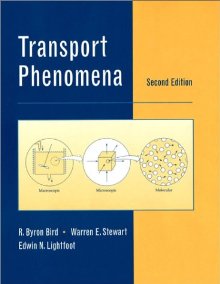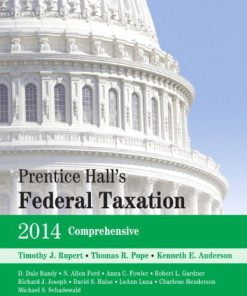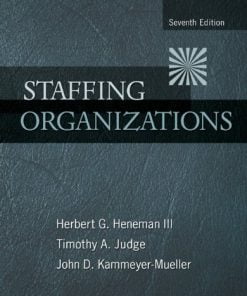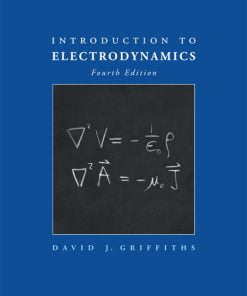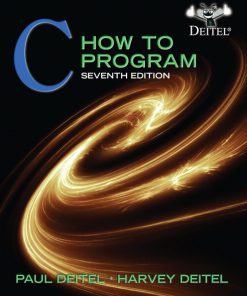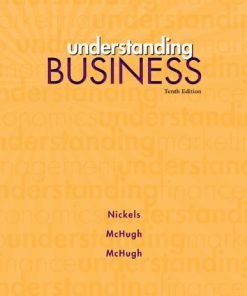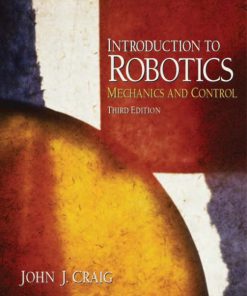Solutions Manual to accompany Transport Phenomena 2nd edition 9780471410775
$35.00 Original price was: $35.00.$26.50Current price is: $26.50.
Solutions Manual to accompany Transport Phenomena 2nd edition 9780471410775
This is completed downloadable of Solutions Manual to accompany Transport Phenomena 2nd edition 9780471410775
Product Details:
- ISBN-10 : 0471410772
- ISBN-13 : 978-0471410775
- Author: R. Byron Bird (Author), Warren E. Stewart (Author), Edwin N. Lightfoot (Author)
Careful attention is paid to the presentation of the basic theory.
* Enhanced sections throughout text provide much firmer foundation than the first edition.
* Literature citations are given throughout for reference to additional material.
Table of Content:
- Chapter 0. The Subject of Transport Phenomena
- Part One. Momentum Transport
- Chapter 1. Viscosity and the Mechanisms of Momentum Transport
- 1.1 Newton’s Law of Viscosity (Molecular Momentum Transport)
- EXAMPLE 1.1-1 Calculation of Momentum Flux
- 1.2 Generalization of Newton’s Law of Viscosity
- 1.3 Pressure and Temperature Dependence of Viscosity
- EXAMPLE 1.3-1 Estimation of Viscosity from Critical Properties
- 1.4 Molecular Theory of the Viscosity of Gases at Low Density
- EXAMPLE 1.4-1 Computation of the Viscosity of a Pure Gas at Low Density
- EXAMPLE 1.4-2 Prediction of the Viscosity of a Gas Mixture at Low Density
- 1.5 Molecular Theory of the Viscosity of Liquids
- EXAMPLE 1.5-1 Estimation of the Viscosity of a Pure Liquid
- 1.6 Viscosity of Suspensions and Emulsions
- 1.7 Convective Momentum Transport
- Questions for Discussion
- Problems
- Chapter 2. Shell Momentum Balances and Velocity Distributions in Laminar Flow
- 2.1 Shell Momentum Balances and Boundary Conditions
- 2.2 Flow of a Falling Film
- EXAMPLE 2.2-1 Calculation of Film Velocity
- EXAMPLE 2.2-2 Falling Film with Variable Viscosity
- 2.3 Flow Through a Circular Tube
- EXAMPLE 2.3-1 Determination of Viscosity from Capillary Flow Data
- EXAMPLE 2.3-2 Compressible Flow in a Horizontal Circular Tube
- 2.4 Flow through an Annulus
- 2.5 Flow of Two Adjacent Immiscible Fluids
- 2.6 Creeping Flow around a Sphere
- EXAMPLE 2.6-1 Determination of Viscosity from the Terminal Velocity of a Falling Sphere
- Questions for Discussion
- Problems
- Chapter 3. The Equations of Change for Isothermal Systems
- 3.1 The Equation of Continuity
- EXAMPLE 3.1-1 Normal Stresses at Solid Surfaces for Incompressible Newtonian Fluids
- 3.2 The Equation of Motion
- 3.3 The Equation of Mechanical Energy
- 3.4 The Equation of Angular Momentum
- 3.5 The Equations of Change in Terms of the Substantial Derivative
- EXAMPLE 3.5-1 The Bernoulli Equation for the Steady Flow of Inviscid Fluids
- 3.6 Use of the Equations of Change to Solve Flow Problems
- EXAMPLE 3.6-1 Steady Flow in a Long Circular Tube
- EXAMPLE 3.6-2 Falling Film with Variable Viscosity
- EXAMPLE 3.6-3 Operation of a Couette Viscometer
- EXAMPLE 3.6-4 Shape of the Surface of a Rotating Liquid
- EXAMPLE 3.6-5 Flow near a Slowly Rotating Sphere
- 3.7 Dimensional Analysis of the Equations of Change
- EXAMPLE 3.7-1 Transverse Flow around a Circular Cylinder
- EXAMPLE 3.7-2 Steady Flow in an Agitated Tank
- EXAMPLE 3.7-3 Pressure Drop for Creeping Flow in a Packed Tube
- Questions for Discussion
- Problems
- Chapter 4. Velocity Distributions with More than One Independent Variable
- 4.1 Time-Dependent Flow of Newtonian Fluids
- EXAMPLE 4.1-1 Flow near a Wall Suddenly Set in Motion
- EXAMPLE 4.1-2 Unsteady Laminar Flow between Two Parallel Plates
- EXAMPLE 4.1-3 Unsteady Laminar Flow near an Oscillating Plate
- 4.2 Solving Flow Problems Using a Stream Function
- EXAMPLE 4.2-1 Creeping Flow around a Sphere
- 4.3 Flow of Inviscid Fluids by Use of the Velocity Potential
- EXAMPLE 4.3-1 Potential Flow around a Cylinder
- EXAMPLE 4.3-2 Flow into a Rectangular Channel
- EXAMPLE 4.3-3 Flow near a Corner
- 4.4 Flow near Solid Surfaces by Boundary-Layer Theory
- EXAMPLE 4.4-1 Laminar Flow along a Flat Plate (Approximate Solution)
- EXAMPLE 4.4-2 Laminar Flow along a Flat Plate (Exact Solution)
- EXAMPLE 4.4-3 Flow near a Corner
- Questions for Discussion
- Problems
- Chapter 5. Velocity Distributions in Turbulent Flow
- 5.1 Comparisons of Laminar and Turbulent Flows
- 5.2 Time-Smoothed Equations of Change for Incompressible Fluids
- 5.3 The Time-Smoothed Velocity Profile near a Wall
- 5.4 Empirical Expressions for the Turbulent Momentum Flux
- EXAMPLE 5.4-1 Development of the Reynolds Stress Expression in the Vicinity of the Wall
- 5.5 Turbulent Flow in Ducts
- EXAMPLE 5.5-1 Estimation of the Average Velocity in a Circular Tube
- EXAMPLE 5.5-2 Application of Prandtl’s Mixing Length Formula to Turbulent Flow in a Circular Tube
- EXAMPLE 5.5-3 Relative Magnitude of Viscosity and Eddy Viscosity
- 5.6 Turbulent Flow in Jets
- EXAMPLE 5.6-1 Time-Smoothed Velocity Distribution in a Circular Wall Jet
- Questions for Discussion
- Problems
- Chapter 6. Interphase Transport in Isothermal Systems
- 6.1 Definition of Friction Factors
- 6.2 Friction Factors for Flow in Tubes
- EXAMPLE 6.2-1 Pressure Drop Required for a Given Flow Rate
- EXAMPLE 6.2-2 Flow Rate for a Given Pressure Drop
- 6.3 Friction Factors for Flow around Spheres
- EXAMPLE 6.3-1 Determination of the Diameter of a Falling Sphere
- 6.4 Friction Factors for Packed Columns
- Questions for Discussion
- Problems
- Chapter 7. Macroscopic Balances for Isothermal Flow Systems
- 7.1 The Macroscopic Mass Balance
- EXAMPLE 7.1-1 Draining of a Spherical Tank
- 7.2 The Macroscopic Momentum Balance
- EXAMPLE 7.2-1 Force Exerted by a Jet (Part a)
- 7.3 The Macroscopic Angular Momentum Balance
- EXAMPLE 7.3-1 Torque on a Mixing Vessel
- 7.4 The Macroscopic Mechanical Energy Balance
- EXAMPLE 7.4-1 Force Exerted by a Jet (Part b)
- 7.5 Estimation of the Viscous Loss
- EXAMPLE 7.5-1 Power Requirement for Pipeline Flow
- 7.6 Use of the Macroscopic Balances for Steady-State Problems
- EXAMPLE 7.6-1 Pressure Rise and Friction Loss in a Sudden Enlargement
- EXAMPLE 7.6-2 Performance of a Liquid–Liquid Ejector
- EXAMPLE 7.6-3 Thrust on a Pipe Bend
- EXAMPLE 7.6-4 The Impinging Jet
- EXAMPLE 7.6-5 Isothermal Flow of a Liquid through an Orifice
- 7.7 Use of the Macroscopic Balances for Unsteady-State Problems
- EXAMPLE 7.7.1 Acceleration Effects in Unsteady Flow from a Cylindrical Tank
- EXAMPLE 7.7-2 Manometer Oscillations
- 7.8 Derivation of the Macroscopic Mechanical Energy Balance
- Questions for Discussion
- Problems
- Chapter 8. Polymeric Liquids
- 8.1 Examples of the Behavior of Polymeric Liquids
- 8.2 Rheometry and Material Functions
- 8.3 Non-Newtonian Viscosity and the Generalized Newtonian Models
- EXAMPLE 8.3-1 Laminar Flow of an Incompressible Power-Law Fluid in a Circular Tube
- EXAMPLE 8.3-2 Flow of a Power-Law Fluid in a Narrow Slit
- EXAMPLE 8.3-3 Tangential Annular Flow of a Power-Law Fluid
- 8.4 Elasticity and the Linear Viscoelastic Models
- EXAMPLE 8.4-1 Small-Amplitude Oscillatory Motion
- EXAMPLE 8.4-2 Unsteady Viscoelastic Flow near an Oscillating Plate
- 8.5 The Corotational Derivatives and the Nonlinear Viscoelastic Models
- EXAMPLE 8.5-1 Material Functions for the Oldroyd 6-Constant Model
- 8.6 Molecular Theories for Polymeric Liquids
- EXAMPLE 8.6-1 Material Functions for the FENE-P Model
- Questions for Discussion
- Problems
- Part Two. Energy Transport
- Chapter 9. Thermal Conductivity and the Mechanisms of Energy Transport
- 9.1 Fourier’s Law of Heat Conduction (Molecular Energy Transport)
- EXAMPLE 9.1-1 Measurement of Thermal Conductivity
- 9.2 Temperature and Pressure Dependence of Thermal Conductivity
- EXAMPLE 9.2-1 Effect of Pressure on Thermal Conductivity
- 9.3 Theory of Thermal Conductivity of Gases at Low Density
- EXAMPLE 9.3-1 Computation of the Thermal Conductivity of a Monatomic Gas at Low Density
- EXAMPLE 9.3-2 Estimation of the Thermal Conductivity of a Polyatomic Gas at Low Density
- EXAMPLE 9.3-3 Prediction of the Thermal Conductivity of a Gas Mixture at Low Density
- 9.4 Theory of Thermal Conductivity of Liquids
- EXAMPLE 9.4-1 Prediction of the Thermal Conductivity of a Liquid
- 9.5 Thermal Conductivity of Solids
- 9.6 Effective Thermal Conductivity of Composite Solids
- 9.7 Convective Transport of Energy
- 9.8 Work Associated with Molecular Motions
- Questions for Discussion
- Problems
- Chapter 10. Shell Energy Balances and Temperature Distributions in Solids and Laminar Flow
- 10.1 Shell Energy Balances; Boundary Conditions
- 10.2 Heat Conduction with an Electrical Heat Source
- EXAMPLE 10.2-1 Voltage Required for a Given Temperature Rise in a Wire Heated by an Electric Current
- EXAMPLE 10.2-2 Heated Wire with Specified Heat Transfer Coefficient and Ambient Air Temperature
- 10.3 Heat Conduction with a Nuclear Heat Source
- 10.4 Heat Conduction with a Viscous Heat Source
- 10.5 Heat Conduction with a Chemical Heat Source
- 10.6 Heat Conduction through Composite Walls
- EXAMPLE 10.6-1 Composite Cylindrical Walls
- 10.7 Heat Conduction in a Cooling Fin
- EXAMPLE 10.7-1 Error in Thermocouple Measurement
- 10.8 Forced Convection
- 10.9 Free Convection
- Questions for Discussion
- Problems
- Chapter 11. The Equations of Change for Nonisothermal Systems
- 11.1 The Energy Equation
- 11.2 Special Forms of the Energy Equation
- 11.3 The Boussinesq Equation of Motion for Forced and Free Convection
- 11.4 Use of the Equations of Change to Solve Steady-State Problems
- EXAMPLE 11.4-1 Steady-State Forced-Convection Heat Transfer in Laminar Flow in a Circular Tube
- EXAMPLE 11.4-2 Tangential Flow in an Annulus with Viscous Heat Generation
- EXAMPLE 11.4-3 Steady Flow in a Nonisothermal Film
- EXAMPLE 11.4-4 Transpiration Cooling
- EXAMPLE 11.4-5 Free Convection Heat Transfer from a Vertical Plate
- EXAMPLE 11.4-6 Adiabatic Frictionless Processes in an Ideal Gas
- EXAMPLE 11.4-7 One-Dimensional Compressible Flow: Velocity, Temperature, and Pressure Profiles in a
- 11.5 Dimensional Analysis of the Equations of Change for Nonisothermal Systems
- EXAMPLE 11.5-1 Temperature Distribution about a Long Cylinder
- EXAMPLE 11.5-2 Free Convection in a Horizontal Fluid Layer; Formation of Bénard Cells
- EXAMPLE 11.5-3 Surface Temperature of an Electrical Heating Coil
- Questions for Discussion
- Problems
- Chapter 12. Temperature Distributions with More than One Independent Variable
- 12.1 Unsteady Heat Conduction in Solids
- EXAMPLE 12.1-1 Heating of a Semi-Infinite Slab
- EXAMPLE 12.1-2 Heating of a Finite Slab
- EXAMPLE 12.1-3 Unsteady Heat Conduction near a Wall with Sinusoidal Heat Flux
- EXAMPLE 12.1-4 Cooling of a Sphere in Contact with a Well-Stirred Fluid
- 12.2 Steady Heat Conduction in Laminar, Incompressible Flow
- EXAMPLE 12.2-1 Laminar Tube Flow with Constant Heat Flux at the Wall
- EXAMPLE 12.2-2 Laminar Tube Flow with Constant Heat Flux at the Wall: Asymptotic Solution for the En
- 12.3 Steady Potential Flow of Heat in Solids
- EXAMPLE 12.3-1 Temperature Distribution in a Wall
- 12.4 Boundary Layer Theory for Nonisothermal Flow
- EXAMPLE 12.4-1 Heat Transfer in Laminar Forced Convection along a Heated Flat Plate (the von Kármá
- EXAMPLE 12.4-2 Heat Transfer in Laminar Forced Convection along a Heated Flat Plate (Asymptotic Solu
- EXAMPLE 12.4-3 Forced Convection in Steady Three-Dimensional Flow at High Prandtl Numbers
- Questions for Discussion
- Problems
- Chapter 13. Temperature Distributions in Turbulent Flow
- 13.1 Time-Smoothed Equations of Change for Incompressible Nonisothermal Flow
- 13.2 The Time-Smoothed Temperature Profile near a Wall
- 13.3 Empirical Expressions for the Turbulent Heat Flux
- EXAMPLE 13.3-1 An Approximate Relation for the Wall Heat Flux for Turbulent Flow in a Tube
- 13.4 Temperature Distribution for Turbulent Flow in Tubes
- 13.5 Temperature Distribution for Turbulent Flow in Jets
- 13.6 Fourier Analysis of Energy Transport in Tube Flow at Large Prandtl Numbers
- Questions for Discussion
- Problems
- Chapter 14. Interphase Transport in Nonisothermal Systems
- 14.1 Definitions of Heat Transfer Coefficients
- EXAMPLE 14.1-1 Calculation of Heat Transfer Coefficients from Experimental Data
- 14.2 Analytical Calculations of Heat Transfer Coefficients for Forced Convection through Tubes and S
- 14.3 Heat Transfer Coefficients for Forced Convection in Tubes
- EXAMPLE 14.3-1 Design of a Tubular Heater
- 14.4 Heat Transfer Coefficients for Forced Convection around Submerged Objects
- 14.5 Heat Transfer Coefficients for Forced Convection through Packed Beds
- 14.6 Heat Transfer Coefficients for Free and Mixed Convection
- EXAMPLE 14.6-1 Heat Loss by Free Convection from a Horizontal Pipe
- 14.7 Heat Transfer Coefficients for Condensation of Pure Vapors on Solid Surfaces
- EXAMPLE 14.7-1 Condensation of Steam on a Vertical Surface
- Questions for Discussion
- Problems
- Chapter 15. Macroscopic Balances for Nonisothermal Systems
- 15.1 The Macroscopic Energy Balance
- 15.2 The Macroscopic Mechanical Energy Balance
- 15.3 Use of the Macroscopic Balances to Solve Steady-State Problems with Flat Velocity Profiles
- EXAMPLE 15.3-1 The Cooling of an Ideal Gas
- EXAMPLE 15.3-2 Mixing of Two Ideal Gas Streams
- 15.4 The d-Forms of the Macroscopic Balances
- EXAMPLE 15.4-1 Parallel- or Counter-Flow Heat Exchangers
- EXAMPLE 15.4-2 Power Requirement for Pumping a Compressible Fluid through a Long Pipe
- 15.5 Use of the Macroscopic Balances to Solve Unsteady-State Problems and Problems with Nonflat Velo
- EXAMPLE 15.5-1 Heating of a Liquid in an Agitated Tank
- EXAMPLE 15.5-2 Operation of a Simple Temperature Controller
- EXAMPLE 15.5-3 Flow of Compressible Fluids through Head Meters
- EXAMPLE 15.5-4 Free Batch Expansion of a Compressible Fluid
- Questions for Discussion
- Problems
- Chapter 16. Energy Transport by Radiation
- 16.1 The Spectrum of Electromagnetic Radiation
- 16.2 Absorption and Emission at Solid Surfaces
- 16.3 Planck’s Distribution Law, Wien’s Displacement Law, and the Stefan–Boltzmann Law
- EXAMPLE 16.3-1 Temperature and Radiation-Energy Emission of the Sun
- 16.4 Direct Radiation between Black Bodies in Vacuo at Different Temperatures
- EXAMPLE 16.4-1 Estimation of the Solar Constant
- EXAMPLE 16.4-2 Radiant Heat Transfer between Disks
- 16.5 Radiation between Nonblack Bodies at Different Temperatures
- EXAMPLE 16.5-1 Radiation Shields
- EXAMPLE 16.5-2 Radiation and Free-Convection Heat Losses from a Horizontal Pipe
- EXAMPLE 16.5-3 Combined Radiation and Convection
- 16.6 Radiant Energy Transport in Absorbing Media
- EXAMPLE 16.6-1 Absorption of a Monochromatic Radiant Beam
- Questions for Discussion
- Problems
- Part Three. Mass Transport
- Chapter 17. Diffusivity and the Mechanisms of Mass Transport
- 17.1 Fick’s Law of Binary Diffusion (Molecular Mass Transport)
- EXAMPLE 17.1-1. Diffusion of Helium through Pyrex Glass
- EXAMPLE 17.1-2 The Equivalence of DAB and DBA
- 17.2 Temperature and Pressure Dependence of Diffusivities
- EXAMPLE 17.2-1 Estimation of Diffusivity at Low Density
- EXAMPLE 17.2-2 Estimation of Self-Diffusivity at High Density
- EXAMPLE 17.2-3 Estimation of Binary Diffusivity at High Density
- 17.3 Theory of Diffusion in Gases at Low Density
- EXAMPLE 17.3-1 Computation of Mass Diffusivity for Low-Density Monatomic Gases
- 17.4 Theory of Diffusion in Binary Liquids
- EXAMPLE 17.4-1 Estimation of Liquid Diffusivity
- 17.5 Theory of Diffusion in Colloidal Suspensions
- 17.6 Theory of Diffusion in Polymers
- 17.7 Mass and Molar Transport by Convection
- 17.8 Summary of Mass and Molar Fluxes
- 17.9 The Maxwell–Stefan Equations for Multicomponent Diffusion in Gases at Low Density
- Questions for Discussion
- Problems
- Chapter 18. Concentration Distributions in Solids and Laminar Flow
- 18.1 Shell Mass Balances; Boundary Conditions
- 18.2 Diffusion through a Stagnant Gas Film
- EXAMPLE 18.2-1 Diffusion with a Moving Interface
- EXAMPLE 18.2-2 Determination of Diffusivity
- EXAMPLE 18.2-3 Diffusion through a Nonisothermal Spherical Film
- 18.3 Diffusion with a Heterogeneous Chemical Reaction
- EXAMPLE 18.3-1 Diffusion with a Slow Heterogeneous Reaction
- 18.4 Diffusion with a Homogeneous Chemical Reaction
- EXAMPLE 18.4-1 Gas Absorption with Chemical Reaction in an Agitated Tank
- 18.5 Diffusion into a Falling Liquid Film (Gas Absorption)
- EXAMPLE 18.5-1 Gas Absorption from Rising Bubbles
- 18.6 Diffusion into a Falling Liquid Film (Solid Dissolution)
- 18.7 Diffusion and Chemical Reaction inside a Porous Catalyst
- 18.8 Diffusion in a Three-Component Gas System
- Questions for Discussion
- Problems
- Chapter 19. Equations of Change for Multicomponent Systems
- 19.1 The Equations of Continuity for a Multicomponent Mixture
- EXAMPLE 19.1-1 Diffusion, Convection, and Chemical Reaction
- 19.2 Summary of the Multicomponent Equations of Change
- 19.3 Summary of the Multicomponent Fluxes
- EXAMPLE 19.3-1 The Partial Molar Enthalpy
- 19.4 Use of the Equations of Change for Mixtures
- EXAMPLE 19.4-1 Simultaneous Heat and Mass Transport
- EXAMPLE 19.4-2 Concentration Profile in a Tubular Reactor
- EXAMPLE 19.4-3 Catalytic Oxidation of Carbon Monoxide
- EXAMPLE 19.4-4 Thermal Conductivity of a Polyatomic Gas
- 19.5 Dimensional Analysis of the Equations of Change for Nonreacting Binary Mixtures
- EXAMPLE 19.5-1 Concentration Distribution about a Long Cylinder
- EXAMPLE 19.5-2 Fog Formation during Dehumidification
- EXAMPLE 19.5-3 Blending of Miscible Fluids
- Questions for Discussion
- Problems
- Chapter 20. Concentration Distributions with More than One Independent Variable
- 20.1 Time-Dependent Diffusion
- EXAMPLE 20.1-1 Unsteady-State Evaporation of a Liquid (the “Arnold Problem”)
- EXAMPLE 20.1-2 Gas Absorption with Rapid Reaction
- EXAMPLE 20.1-3 Unsteady Diffusion with First-Order Homogeneous Reaction
- EXAMPLE 20.1-4 Influence of Changing Interfacial Area on Mass Transfer at an Interface
- 20.2 Steady-State Transport in Binary Boundary Layers
- EXAMPLE 20.2-1 Diffusion and Chemical Reaction in Isothermal Laminar Flow along a Soluble Flat Plate
- EXAMPLE 20.2-2 Forced Convection from a Flat Plate at High Mass-Transfer Rates
- EXAMPLE 20.2-3 Approximate Analogies for the Flat Plate at Low Mass-Transfer Rates
- 20.3 Steady-State Boundary-Layer Theory for Flow around Objects
- EXAMPLE 20.3-1 Mass Transfer for Creeping Flow around a Gas Bubble
- 20.4 Boundary Layer Mass Transport with Complex Interfacial Motion
- EXAMPLE 20.4-1 Mass Transfer with Nonuniform Interfacial Deformation
- EXAMPLE 20.4-2 Gas Absorption with Rapid Reaction and Interfacial Deformation
- 20.5 “Taylor Dispersion” in Laminar Tube Flow
- Questions for Discussion
- Problems
- Chapter 21. Concentration Distributions in Turbulent Flow
- 21.1 Concentration Fluctuations and the Time-Smoothed Concentration
- 21.2 Time-Smoothing of the Equation of Continuity of A
- 21.3 Semi-Empirical Expressions for the Turbulent Mass Flux
- 21.4 Enhancement of Mass Transfer by a First-Order Reaction in Turbulent Flow
- 21.5 Turbulent Mixing and Turbulent Flow with Second-Order Reaction
- Questions for Discussion
- Problems
- Chapter 22. Interphase Transport in Nonisothermal Mixtures
- 22.1 Definition of Transfer Coefficients in One Phase
- 22.2 Analytical Expressions for Mass Transfer Coefficients
- 22.3 Correlation of Binary Transfer Coefficients in One Phase
- EXAMPLE 22.3-1 Evaporation from a Freely Falling Drop
- EXAMPLE 22.3-2 The Wet and Dry Bulb Psychrometer
- EXAMPLE 22.3-3 Mass Transfer in Creeping Flow through Packed Beds
- EXAMPLE 22.3-4 Mass Transfer to Drops and Bubbles
- 22.4 Definition of Transfer Coefficients in Two Phases
- EXAMPLE 22.4-1 Determination of the Controlling Resistance
- EXAMPLE 22.4-2 Interaction of Phase Resistances
- EXAMPLE 22.4-3 Area Averaging
- 22.5 Mass Transfer and Chemical Reactions
- EXAMPLE 22.5-1 Estimation of the Interfacial Area in a Packed Column
- EXAMPLE 22.5-2 Estimation of Volumetric Mass Transfer Coefficients
- EXAMPLE 22.5-3 Model-Insensitive Correlations for Absorption with Rapid Reaction
- 22.6 Combined Heat and Mass Transfer by Free Convection
- EXAMPLE 22.6-1 Additivity of Grashof Numbers
- EXAMPLE 22.6-2 Free-Convection Heat Transfer as a Source of Forced-Convection Mass Transfer
- 22.7 Effects of Interfacial Forces on Heat and Mass Transfer
- EXAMPLE 22.7-1 Elimination of Circulation in a Rising Gas Bubble
- EXAMPLE 22.7-2 Marangoni Instability in a Falling Film
- 22.8 Transfer Coefficients at High Net Mass Transfer Rates
- EXAMPLE 22.8-1 Rapid Evaporation of a Liquid from a Plane Surface
- EXAMPLE 22.8-2 Correction Factors in Droplet Evaporation
- EXAMPLE 22.8-3 Wet-Bulb Performance Corrected for Mass-Transfer Rate
- EXAMPLE 22.8-4 Comparison of Film and Penetration Models for Unsteady Evaporation in a Long Tube
- EXAMPLE 22.8-5 Concentration Polarization in Ultrafiltration
- 22.9 Matrix Approximations for Multicomponent Mass Transport
- Questions for Discussion
- Problems
- Chapter 23. Macroscopic Balances for Multicomponent Systems
- 23.1 The Macroscopic Mass Balances
- EXAMPLE 23.1-1 Disposal of an Unstable Waste Product
- EXAMPLE 23.1-2 Binary Splitters
- EXAMPLE 23.1-3 The Macroscopic Balances and Dirac’s “Separative Capacity” and “Value Functio
- EXAMPLE 23.1-4 Compartmental Analysis
- EXAMPLE 23.1-5 Time Constants and Model Insensitivity
- 23.2 The Macroscopic Momentum and Angular Momentum Balances
- 23.3 The Macroscopic Energy Balance
- 23.4 The Macroscopic Mechanical Energy Balance
- 23.5 Use of the Macroscopic Balances to Solve Steady-State Problems
- EXAMPLE 23.5-1 Energy Balances for a Sulfur Dioxide Converter
- EXAMPLE 23.5-2 Height of a Packed-Tower Absorber
- EXAMPLE 23.5-3 Linear Cascades
- EXAMPLE 23.5-4 Expansion of a Reactive Gas Mixture through a Frictionless Adiabatic Nozzle
- 23.6 Use of the Macroscopic Balances to Solve Unsteady-State Problems
- EXAMPLE 23.6-1 Start-Up of a Chemical Reactor
- EXAMPLE 23.6-2 Unsteady Operation of a Packed Column
- EXAMPLE 23.6-3 The Utility of Low-Order Moments
- Questions for Discussion
- Problems
- Chapter 24. Other Mechanisms for Mass Transport
- 24.1 The Equation of Change for Entropy
- 24.2 The Flux Expressions for Heat and Mass
- EXAMPLE 24.2-1 Thermal Diffusion and the Clusius–Dickel Column
- EXAMPLE 24.2-2 Pressure Diffusion and the Ultracentrifuge
- 24.3 Concentration Diffusion and Driving Forces
- 24.4 Applications of the Generalized Maxwell–Stefan Equations
- EXAMPLE 24.4-1 Centrifugation of Proteins
- EXAMPLE 24.4-2 Proteins as Hydrodynamic Particles
- EXAMPLE 24.4-3 Diffusion of Salts in an Aqueous Solution
- EXAMPLE 24.4-4 Departures from Local Electroneutrality: Electro-Osmosis
- EXAMPLE 24.4-5 Additional Mass-Transfer Driving Forces
- 24.5 Mass Transport across Selectively Permeable Membranes
- EXAMPLE 24.5-1 Concentration Diffusion between Preexisting Bulk Phases
- EXAMPLE 24.5-2 Ultrafiltration and Reverse Osmosis
- EXAMPLE 24.5-3 Charged Membranes and Donnan Exclusion
- 24.6 Mass Transport in Porous Media
- EXAMPLE 24.6-1 Knudsen Diffusion
- EXAMPLE 24.6-2 Transport from a Binary External Solution
- Questions for Discussion
- Problems
- Postface
- Appendices
- appendix A. Vector and Tensor Notation
- A.1 Vector Operations from a Geometrical Viewpoint
- A.2 Vector Operations in Terms of Components
- EXAMPLE A.2-1 Proof of a Vector Identity
- A.3 Tensor Operations in Terms of Components
- A.4 Vector and Tensor Differential Operations
- EXAMPLE A.4-1 Proof of a Tensor Identity
- A.5 Vector and Tensor Integral Theorems
- A.6 Vector and Tensor Algebra in Curvilinear Coordinates
- A.7 Differential Operations in Curvilinear Coordinates
- EXAMPLE A.7-1 Differential Operations in Cylindrical Coordinates
- EXAMPLE A.7-2 Differential Operations in Spherical Coordinates
- A.8 Integral Operations in Curvilinear Coordinates
- A.9 Further Comments on Vector–Tensor Notation
- appendix B. Fluxes and the Equations of Change
- B.1 Newton’s Law of Viscosity
- B.2 Fourier’s Law of Heat Conduction
- B.3 Fick’s (First) Law of Binary Diffusion
- B.4 The Equation of Continuity
- B.5 The Equation of Motion in Terms of τ
- B.6 The Equation of Motion for a Newtonian Fluid with Constant ρ and μ
- B.7 The Dissipation Function Фv for Newtonian Fluids
- B.8 The Equation of Energy in Terms of q
- B.9 The Equation of Energy for Pure Newtonian Fluids with Constant ρ and k
- B.10 The Equation of Continuity for Species α in Terms of jα
- B.11 The Equation of Continuity for Species A in Terms of ωA for Constant ρDAB
- appendix C. Mathematical Topics
- C.1 Some Ordinary Differential Equations and Their Solutions
- C.2 Expansions of Functions in Taylor Series
- C.3 Differentiation of Integrals (the Leibniz Formula)
- C.4 The Gamma Function
- C.5 The Hyperbolic Functions
- C.6 The Error Function
- appendix D. The Kinetic Theory of Gases
- D.1 The Boltzmann Equation
- D.2 The Equations of Change
- D.3 The Molecular Expressions for the Fluxes
- D.4 The Solution to the Boltzmann Equation
- D.5 The Fluxes in Terms of the Transport Properties
- D.6 The Transport Properties in Terms of the Intermolecular Forces
- D.7 Concluding Comments
- appendix E. Tables for Prediction of Transport Properties
- E.1 Intermolecular Force Parameters and Critical Properties
- E.2 Functions for Prediction of Transport Properties of Gases at Low Densities
- appendix F. Constants and Conversion Factors
- F.1 Mathematical Constants
- F.2 Physical Constants
- F.3 Conversion Factors
- Notation
- Author Index
- Subject Index
- About the Authors
People Also Search:
transport phenomena revised 2nd edition solution manual
transport phenomena revised 2nd edition pdf
transport phenomena revised 2nd edition
Related products
Solution Manual
Prentice Hall’s Federal Taxation 2014 Comprehensive Rupert 27th Edition Solutions Manual
Solution Manual
Solution Manual for Introduction to Electrodynamics, 4/E 4th
Solution Manual
Understanding Business Nickels 10th Edition Solutions Manual
Solution Manual
Solution Manual for Introduction to Robotics Mechanics and Control 3rd Edition by Craig
Solution Manual




